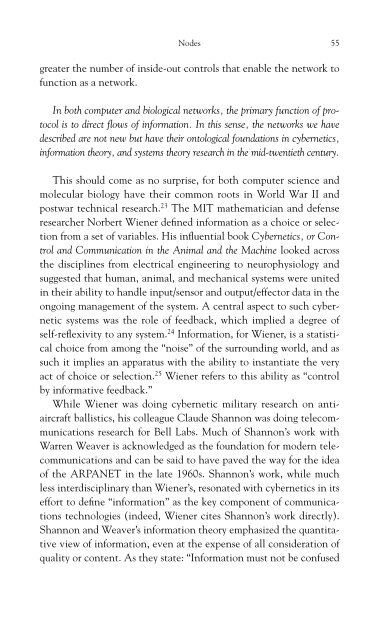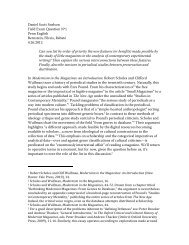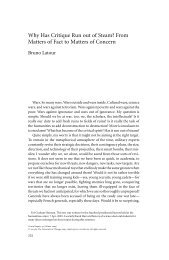The Exploit: A Theory of Networks - asounder
The Exploit: A Theory of Networks - asounder
The Exploit: A Theory of Networks - asounder
Create successful ePaper yourself
Turn your PDF publications into a flip-book with our unique Google optimized e-Paper software.
Nodes 55<br />
greater the number <strong>of</strong> inside - out controls that enable the network to<br />
function as a network.<br />
In both computer and biological networks, the primary function <strong>of</strong> protocol<br />
is to direct flows <strong>of</strong> information. In this sense, the networks we have<br />
described are not new but have their ontological foundations in cybernetics,<br />
information theory, and systems theory research in the mid - twentieth century.<br />
This should come as no surprise, for both computer science and<br />
molecular biology have their common roots in World War II and<br />
postwar technical research. 23 <strong>The</strong> MIT mathematician and defense<br />
researcher Norbert Wiener defined information as a choice or selection<br />
from a set <strong>of</strong> variables. His influential book Cybernetics, or Control<br />
and Communication in the Animal and the Machine looked across<br />
the disciplines from electrical engineering to neurophysiology and<br />
suggested that human, animal, and mechanical systems were united<br />
in their ability to handle input/ sensor and output/ effector data in the<br />
ongoing management <strong>of</strong> the system. A central aspect to such cybernetic<br />
systems was the role <strong>of</strong> feedback, which implied a degree <strong>of</strong><br />
self - reflexivity to any system. 24 Information, for Wiener, is a statistical<br />
choice from among the “noise” <strong>of</strong> the surrounding world, and as<br />
such it implies an apparatus with the ability to instantiate the very<br />
act <strong>of</strong> choice or selection. 25 Wiener refers to this ability as “control<br />
by informative feedback.”<br />
While Wiener was doing cybernetic military research on anti -<br />
aircraft ballistics, his colleague Claude Shannon was doing telecommunications<br />
research for Bell Labs. Much <strong>of</strong> Shannon’s work with<br />
Warren Weaver is acknowledged as the foundation for modern tele -<br />
communications and can be said to have paved the way for the idea<br />
<strong>of</strong> the ARPANET in the late 1960s. Shannon’s work, while much<br />
less interdisciplinary than Wiener’s, resonated with cybernetics in its<br />
effort to define “information” as the key component <strong>of</strong> communications<br />
technologies (indeed, Wiener cites Shannon’s work directly).<br />
Shannon and Weaver’s information theory emphasized the quantitative<br />
view <strong>of</strong> information, even at the expense <strong>of</strong> all consideration <strong>of</strong><br />
quality or content. As they state: “Information must not be confused









